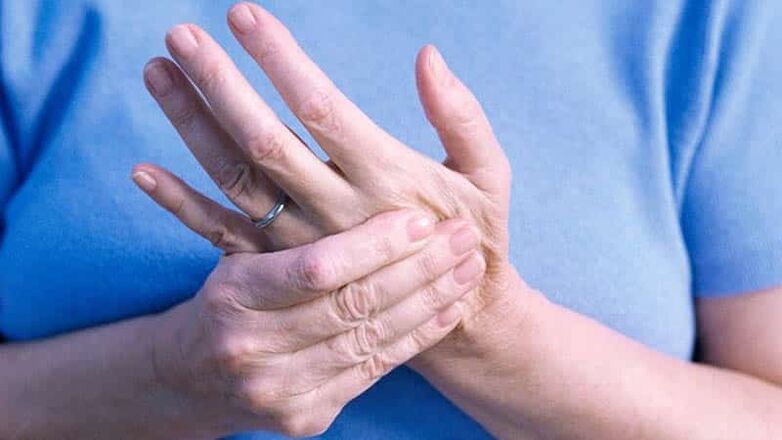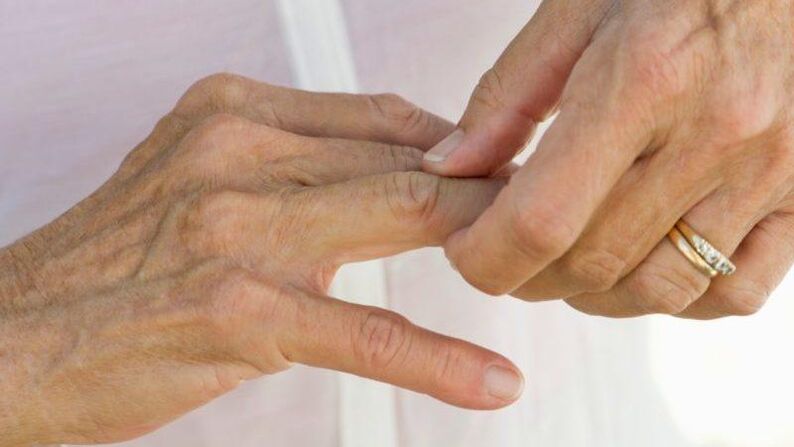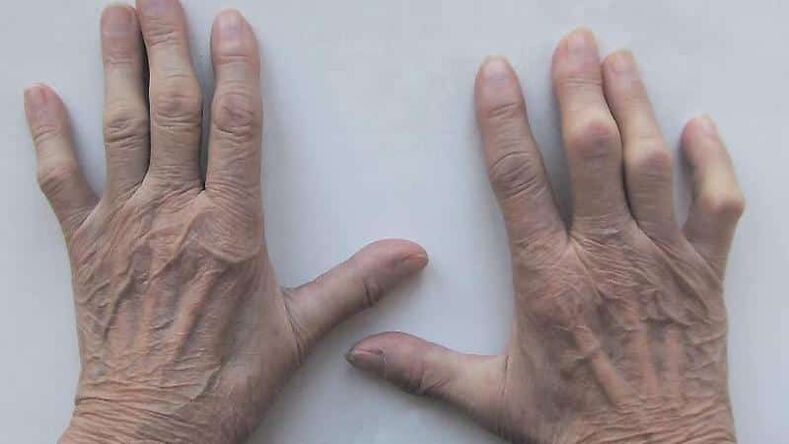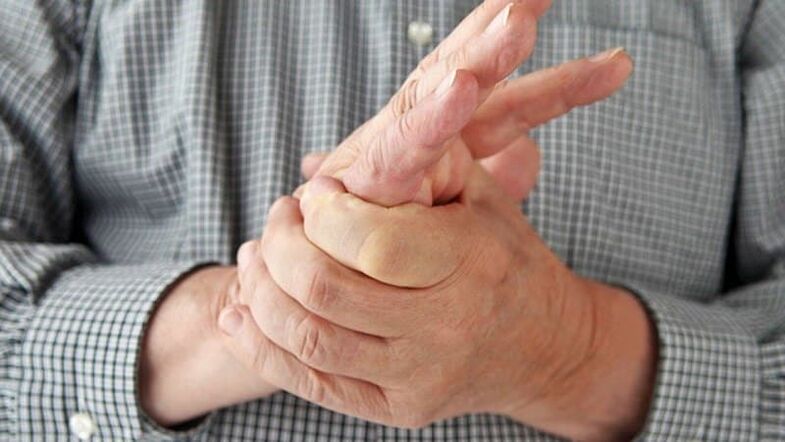Hands are the main working tool of a person, and the fingers are able to perform the smallest operations.Over time, the joints wear out as a result of mechanical exposure, monotonous work, mineral deficiency, adverse environment and pathologies of the bone muscle system.
What to do if the joints of your fingers are painful on the hands, how and what to treat the pain in the tips of your fingers and other diseases, you will learn from the article.
The reasons for the pain
The reasons why the fingers hurt on the hands are numerous and varied.The nature of the discomfort depends on a number of diseases of the musculoskeletal system, the power of load on the limbs, diet and lifestyle of human life.
The pain syndrome, accompanied by an inflammatory process, manifests itself in the form of limited movements in the morning after waking up.The unpleasant sensations go after simple movements.Patients complain of redness, smoke in the fingers, swelling and reduction of flexibility.
Mechanical pain is accompanied by symptoms of local inflammation.The nature of their severity is insignificant, so patients often do not pay attention to them.
Tied to diseases of the musculoskeletal system

Fingers on the hands appear due to diseases such as:
- Rheumatoid arthritisSIt is an autoimmune disease with an inflammatory nature.It is characterized by the speed of the process and soon develops in chronic form.It delivers very unpleasant sensations to the patient.The disease mainly affects small joints, rarely large joints and internal organs participate in the pathological process.It hurts to bend the middle and ring finger.Swelling, redness of the skin develops, the phalans become hot to the touch.Intense pain syndrome prevents you from pulling your hand into your fist.The degenerative process affects both upper limbs.The joints hurt in the morning or at night.The discomfort goes closer to the evening.
- Psoriatic arthritisSThe disease is directly related to skin damage - psoriasis.The pain in the joints is localized in the nail area.The phalanx swells so much that they look like red sausages with a bluish tinge.It is difficult for the patient to terminate the brush, the tip of the finger on his hand hurts when pressed.
- Infectious arthritisSThe characteristic signs of the disease at the initial stage are often lacking completely.The development of the pathology is evidenced by the onset of acute pain, which lasts for several hours or days.The affected joints become hot to the touch.The patient increases body temperature, chills appear.
- GoutSThe disease is more common in people who have reached the age of fifties.The cause of the pathology is a violation of uric acid metabolism.As a result, the urea slows down in the body and is deposited in the cartilage and joint tissue, complicating the motor functions.Burning and severe pain are loyal satellites of the disease.
- OsteoarthrosisSThe disease develops due to degenerative changes in the joints.There is a thickening of the joints and as a result - a restriction on mobility.More often, the disease is diagnosed in women in the after -confidence.This is due to a decrease in estrogen production.The hereditary factor, impaired metabolism, intense physical activity also cause the development of pathology.In addition to the pain, the disease is characterized by the appearance of nodes under the skin and swelling of the joints.The phalanges of the hands are deformed, thickened in the middle and acquire a spindle.
- Streaming ligamentSThe disease has common symptoms with arthrosis and arthritis.X -ray helps to understand the cause.The clinical picture is characterized by soreness when bending and lengthening the brush.Sometimes a fist is difficult to stand up.Extensions are heard clicks.
- RiaarthrosisSThe pathology is manifested by pain in the joints of the thumbs.It manifests as a result of the intense loading of the upper limbs, infections, intoxication and injuries.The diagnosis is made by the doctor after an external examination.There is acute pain when stretching the finger, the discomfort is increased by load: rotate the key and the door handle, open the lid.At the initial stage, the thumb hurts at the base.Then the unpleasant sensations are preserved even at rest.Over time, the joints deform, the movements are difficult.The patient loses the ability to squeeze his fingers.
- RheumatismSThe disease is characterized by acute unexpected pain.The manual phalanges turn red, swell, the motor functions are impaired.A rash occurs on the skin, body temperature rises.
- TenstovaginitisSThe pathological process of inflammatory nature is accompanied by chronic damage to the tendon membranes.The characteristic signs of the disease are crunching in the joints, soreness during lengthening and bending, swelling of the tendon case.The patient cannot squeeze his hand into a fist, weakness appears.
Other reasons

Finger pain syndrome develops not only due to diseases of the musculoskeletal system.Other countries contribute to this:
- PregnancySSwelling and pain in the joints occur due to an increase in the level of the hormone relaxin, which is responsible for softening the bonds, calcium deficiency, pinching of the middle nerve, fibromyalgia.
- PostpartumSFingers and hands whine with lack of calcium, pathological changes in the joints.
- Intense physical activitySPain syndrome occurs as a result of a disorder of blood vessels.The discomfort is accompanied by numbness and convulsions.The skin becomes pale, turns cold, the nail plate thickens.Without treatment, the disease develops in chronic form.There is a violation of the blood supply to the limbs and the passage of the upper arteries is narrowed.The pain takes on a constant character and reminds itself of the lowest load, the bones and phalans hurt when bending.
Finger pain is provoked by factors such as:
- infectious processes in joint tissue;
- autoimmune pathologies;
- joints of the joints;
- Injuries and fractures;
- Vitamin deficiency;
- impaired metabolism;
- smoking;
- alcohol abuse;
- heredity;
- thyroid disorder;
- Diabetes sugar;
- hypothermia;
- constant contact with vibration sources;
- Monotonous movements of the hands (tunnel syndrome in which the little finger and index finger from the right hand lose sensitivity).
Diagnostic methods
The methodology for determining diseases of the upper limb joints includes such types of procedures:
- X -raySIt helps to identify injuries, tumors, infectious lesions to examine the structure of bone tissue.
- UltrasoundSIn practice, they are rarely used because the study does not allow a clear picture to be obtained due to the high bone density.
- Computed tomography.The method allows you to get bone cut, to identify changes in tissues.
- ElectroShSThis is a computer study that detects pathologies in those areas of the spine that are responsible for the functions of the upper limbs.Helps identify diseases in the early stages.
- MRISA safe and accurate method for diagnosing tissues using electromagnetic waves.The picture shows transverse and longitudinal sections.
- ContrastSThe diagnosis is carried out by the introduction of a special substance that helps to distinguish areas of pathology.
- General analysis of urine and bloodSHelp determine severe arthritis, anemia and leukocytosis.The biochemical blood test reveals the level of fibrinogen, gapoglobin, sialic acids.
- Joint puncture.The topic of the study is synovial fluid.The method is used to accurately determine the causes of inflammatory processes.
- Skin biopsySThe study is conducted to determine rare types of arthritis against the background of red lupus, scleroderma.
ReferenceSIf necessary to clarify the diagnosis, the doctor prescribes additional studies: determining the level of urea, lupus cells and rheumatoid factor.
When to see a doctor

Experts recommend that you seek medical attention in case of discomfort and joint pain when it turns and rotates the tips of your fingers.This will allow you to determine the nature of the disease in a timely manner and to begin treatment.
The study of pathologies of the musculoskeletal system is engaged in:
- rheumatologist- examines connective tissues, joint dysfunctions;
- surgeon-dying problems through surgical intervention, conducts an examination to identify diseases of the musculoskeletal system;
- Neuropathologistwill help in pinching nerve endings, numbness of the limbs;
- traumatologistdeals with problems resulting from injuries, various bone damage, ligaments, tendons;
- hematologistHe deals with the pathologies of the ode to the background of blood diseases.
Methods of treatment
How and how to treat the pain in your fingers?The treatment of finger pain syndrome is aimed at eliminating the disease, which has led to the appearance of unpleasant sensations.
If the pain occurs as a result of inflammation, antibacterial drugs, hormones and NSAIDs are prescribed.With dystrophic changes, the affected joints using chondroprotectors, physiotherapy procedures, manual therapy, massage and educational institutions are restored.
Medication
An integrated approach is used in the treatment of diseases of the musculoskeletal system.Analgesics are used to relieve the symptoms of pathological changes.Chondroprotectors help to restore cartilage and fill the deficiency of minerals and collagen.
Non -steroidal anti -inflammatory drugs are suitable for symptomatic treatment that help eliminates pain and inflammation in the joints.The most popular and safe means:
- for oral use -non -steroidal anti -inflammatory drugs;
- For topical application - ointments, creams and gels with painkillers.
Glucocorticoids are effective for rheumatoid arthritis.Doctors prescribe medicines for both internal and external use.
Important!After elimination of acute symptoms, immunosuppressants and antitumor drugs are prescribed.
Exercise and massage therapy
Therapeutic physical education and massage help to restore local blood circulation, improve tissue trophic tissue, saturate them with oxygen and optimize motor functions.
Examples of finger gymnastics:
- In a sitting position, bend your hand in the elbow and place on the thigh or pillow, the palm is directed down.At the same time, or alternatively, reduce and breed the phalanges of the hands.
- The carts of the support, half bend your fingers.Raise your hands up.
- Press your palms to the maintenance.Take your thumbs and alternatively attach the remaining fingers to them.
- Press your palms to the support and lift your brushes.
- Bend and extend your fingers.
- Exercises should be repeated 5 times.
Massage techniques are effective in joint diseases.Patients using self -massage indicate an improvement in the condition.Pain and swelling leaves.The movements of the fingers are made in the direction of the edges of the phalanx to the base of the bones.Each finger massage individually.
The procedure is divided into three stages:
- Light stroke without tension.
- The rubbing is done using a pinch (directly, zigzag, spiral).
- Shake is done at the end of the massage.
Physiotherapy

Physiotherapy procedures accelerate and enhance the therapeutic effect of other procedures.Depending on the characteristics of the disease, patients are prescribed paraffin therapy, ultrasound and mud.Electrophoresis with anesthetic solutions, resonance therapy and electricity can reduce pain.
Thermal therapy is based on an increase in temperature in the affected joint.This stimulates metabolism, restores cartilage.The procedure is used if the drug treatment of thumb disease and other phalanges does not help.
Prevention methods
To prevent the development of degenerative and dystrophic processes in bone and muscle tissue, doctors recommend:
- Stick to the right diet (enriching the diet with iron, phosphorus, calcium);
- abandon bad habits (alcohol, smoking);
- a dose of physical activity and their intensity;
- Follow a diet (turn off fat, salty, spicy foods).
It is advisable to eat more frequently: fish, seafood, natural cheese and cottage cheese with low fat content, salads, radishes, eggs, currant, nuts, grenades, figs, colored cabbage, olive oil, ginger, flaxseed oil.
Omega-3 fatty acids improve the condition of the vascular system, normalize fat metabolism.Apple cider vinegar is pleasing to the blood and removes salt.
Conclusion
The painful sensations in the fingers develop due to diseases of the musculoskeletal system, intense physical activity, bad habits and disorders of power.The hereditary factor plays an important role in the development of pathology and carries a lot of discomfort to patients.
Treatment is aimed at eliminating root causes, eliminating inflammation and pain.Preventive measures and a healthy lifestyle where proper nutrition helps to prevent the development of the disease.






















